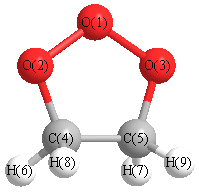Vibrational Frequencies calculated at CCD/TZVP
| Mode Number |
Symmetry |
Frequency
(cm-1) |
Scaled Frequency
(cm-1) |
IR Intensities
(km mol-1) |
Raman Act
(Å4/u) |
Dep P |
Dep U |
|---|
| 1 |
A' |
3194 |
3028 |
27.86 |
|
|
|
| 2 |
A' |
3115 |
2953 |
44.06 |
|
|
|
| 3 |
A' |
1559 |
1478 |
0.20 |
|
|
|
| 4 |
A' |
1400 |
1327 |
0.28 |
|
|
|
| 5 |
A' |
1280 |
1213 |
1.62 |
|
|
|
| 6 |
A' |
1066 |
1011 |
35.84 |
|
|
|
| 7 |
A' |
975 |
924 |
13.21 |
|
|
|
| 8 |
A' |
954 |
904 |
4.37 |
|
|
|
| 9 |
A' |
883 |
837 |
0.95 |
|
|
|
| 10 |
A' |
733 |
695 |
2.32 |
|
|
|
| 11 |
A' |
420 |
398 |
4.40 |
|
|
|
| 12 |
A" |
3177 |
3012 |
0.59 |
|
|
|
| 13 |
A" |
3106 |
2944 |
21.87 |
|
|
|
| 14 |
A" |
1540 |
1460 |
0.50 |
|
|
|
| 15 |
A" |
1393 |
1320 |
0.42 |
|
|
|
| 16 |
A" |
1249 |
1184 |
0.01 |
|
|
|
| 17 |
A" |
1192 |
1130 |
0.01 |
|
|
|
| 18 |
A" |
1077 |
1021 |
2.46 |
|
|
|
| 19 |
A" |
846 |
802 |
25.95 |
|
|
|
| 20 |
A" |
746 |
707 |
5.02 |
|
|
|
| 21 |
A" |
125 |
119 |
3.32 |
|
|
|
Unscaled Zero Point Vibrational Energy (zpe) 15014.4 cm
-1
Scaled (by 0.948) Zero Point Vibrational Energy (zpe) 14233.6 cm
-1
See section
III.C.1 List or set vibrational scaling factors
to change the scale factors used here.
See section
III.C.2
Calculate a vibrational scaling factor for a given set of molecules
to determine the least squares best scaling factor.
